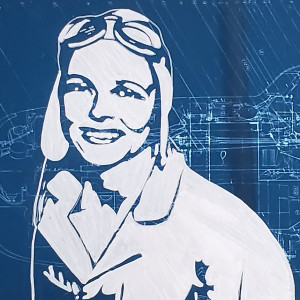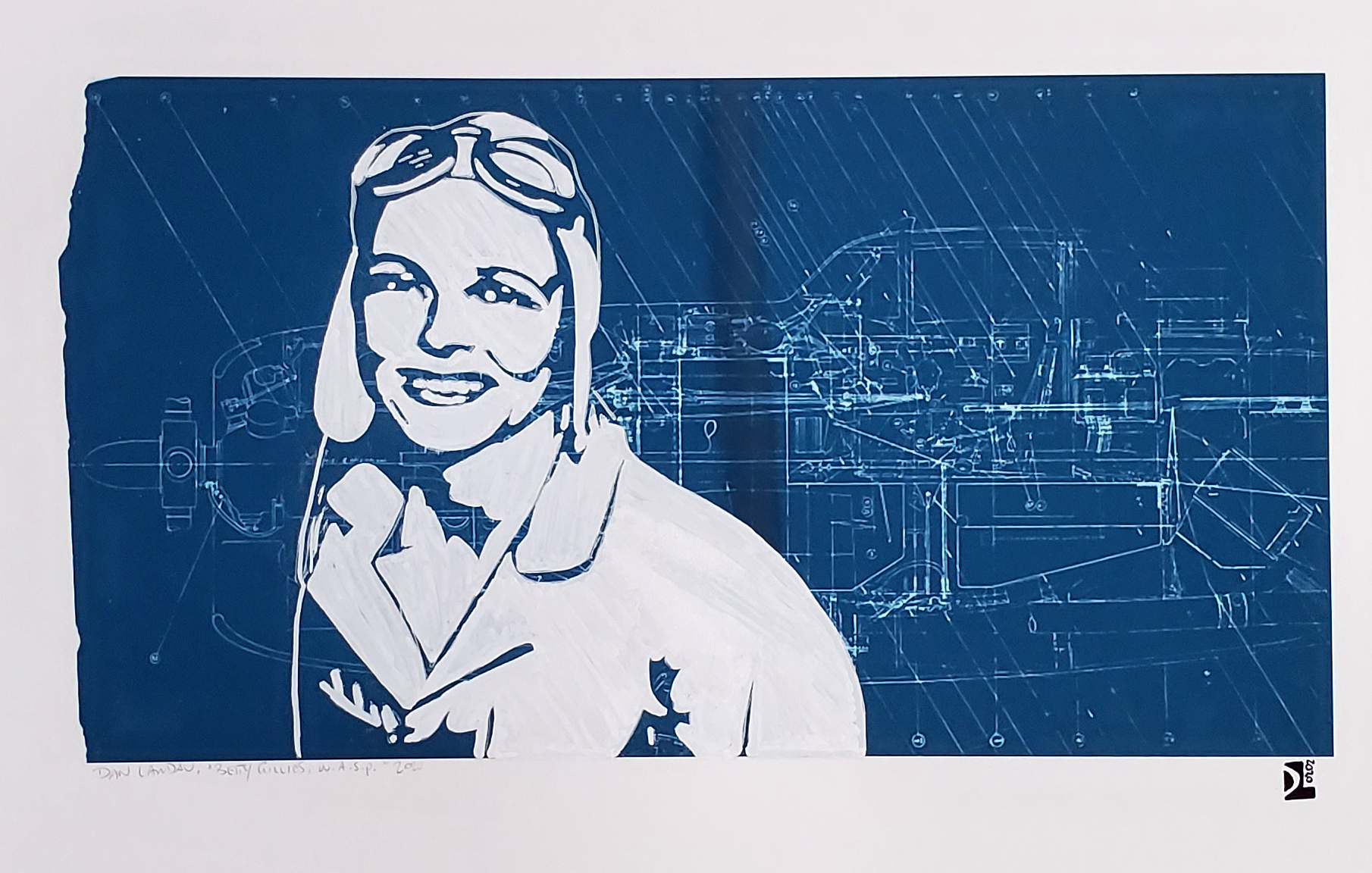
Tuesday Mar 01, 2022
Flying through military barriers: the Women Airforce Service Pilots (WASPs)
“You can be whatever you set your heart and head to be, and don’t let anybody tell you can’t be, because 1,078 women pilots did it in WWII.”
Annelle Henderson Bulechek
Aviator, WASP

Artwork:
To represent the WASPs in in the Fearless Portrait project, I’ve drawn WASP squadron leader, Betty Gillies, in white ink, on a blueprint of a P-47 Thunderbolt fighter plane. The first pilot to fly for the WASP, she was also the first woman to fly the P-47.
The story:
As the WWII war effort strained manpower and resources, women were tapped to fill traditionally male jobs. The US Air Force (then part of the army) was not immune to the manpower shortages and to free up men for combat duty, the Women’s Airforce Service Pilots (WASP) was formed.
Flying more than 60 million miles during the war, the 1,000+ members of the all-female corps flew every single plane in the army’s inventory—78 different types, from the tiny P-51 Mustang fighters to the huge B-29 Superfortress bombers. These women flew 80% of all ferrying missions, delivering 12,000 aircraft from factories to army bases. Additionally, they towed about 90% of the aerial targets for air-to-air combat training and live anti-aircraft artillery practice.
When WASP founder Jacqueline Cochran put out the call for applicants, more than 25,000 women applied. Of those 1,830 were accepted and 1,078 made it through the training. Promised commissions, they were trained as officers and had to follow the rules for officers, they were nevertheless denied officer ranks. They served as civilians, meaning that not only did they not have military rank, they did not have insurance, veteran, burial or death benefits until 1977.
Despite the snub, they served with distinction. General of the Air Force, Henry “Hap” Arnold even used them to show up male pilots. When men didn’t want to fly the difficult B-29 bomber, Arnold recruited two WASPs to fly a B-29 and embarrassed the men into flying it without complaint.
Many men were unhappy with having to work with female pilots and the WASPs faced significant discrimination. Women over 35 weren’t even allowed to enter the WASP, as the military had determined 40 was the beginning of menopause and wanted to ensure none of the WASPs would be entering the time of “debilitating irrationality” while in service.
The WASP was disbanded in December 1944.
“They said we couldn’t do it. We did it, and we did it successfully,” said Annelle Henderson Bulechek, one of the WASPs. “And by, Hap Arnold’s own account, we did it as well as any man could have done it. I think that’s the legacy that we leave behind us—that laws and lawsuits [about getting proper veteran status] and everything else doesn’t make you what you are. It’s what you want to be and what you go ahead and do that counts.”
Music:
This episode contains music by Geovane Bruno and Zakhar Valaha.
Sources:
- Air Space. (n.d.). AirSpace Season 3|Ep.9Fly Girl. National Air and Space Museum. https://airandspace.si.edu/stories/editorial/airspaces3ep9
- Chen, P. C. (n.d.). Betty Gillies. WW2DB. https://ww2db.com/person_bio.php?person_id=505
- Digital Public Library of America. (n.d.-a). Women Air Force Service Pilots (WASPs) | DPLA. https://dp.la/exhibitions/american-aviatrixes/women-air-force-service-pilots/deactivation-of-the-wasps
- Digital Public Library of America. (n.d.-b). Women Air Force Service Pilots (WASPs) | DPLA. https://dp.la/exhibitions/american-aviatrixes/women-air-force-service-pilots
- Pauley, H. (n.d.). The Unsung Heroines of World War II - WASP. Megavision. https://www.megavision.net/wasp/index.html
- Veterans History Project. (2003, March 5). Interview with Annelle Bulechek [03/25/2003]. Library of Congress. http://memory.loc.gov/diglib/vhp/story/loc.natlib.afc2001001.08083/transcript?ID=mv0001
- WASP Annelle Henderson Bulechek. (n.d.). Wings Across America. http://www.wingsacrossamerica.us/web/bulechek_annelle_NEW.htm
- Wikipedia contributors. (2021a, November 10). Betty Gillies. Wikipedia. https://en.wikipedia.org/wiki/Betty_Gillies
- Wikipedia contributors. (2021b, November 24). Women Airforce Service Pilots. Wikipedia. https://en.wikipedia.org/wiki/Women_Airforce_Service_Pilots
No comments yet. Be the first to say something!